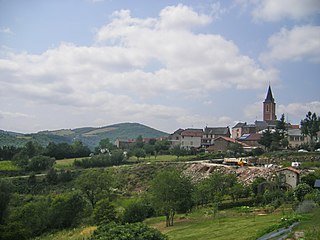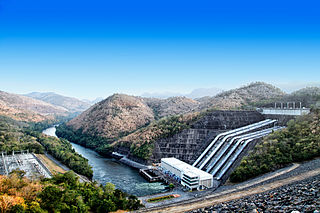
Hydropower, also known as water power, is the use of falling or fast-running water to produce electricity or to power machines. This is achieved by converting the gravitational potential or kinetic energy of a water source to produce power. Hydropower is a method of sustainable energy production. Hydropower is now used principally for hydroelectric power generation, and is also applied as one half of an energy storage system known as pumped-storage hydroelectricity. Hydropower is an attractive alternative to fossil fuels as it does not directly produce carbon dioxide or other atmospheric pollutants and it provides a relatively consistent source of power. Nonetheless, it has economic, sociological, and environmental downsides and requires a sufficiently energetic source of water, such as a river or elevated lake. International institutions such as the World Bank view hydropower as a low-carbon means for economic development.

The Devils Gate Power Station is a conventional hydroelectric power station located in north-western Tasmania, Australia. The dam is 84 metres (276 ft) high. It is one of the thinnest concrete arch dams in the world.

Broquiès is a commune in the Aveyron department in southern France.

Saint-Victor-et-Melvieu is a commune in the Aveyron department in southern France.

Le Truel is a commune in the Aveyron department in southern France. The village was in the ancient province of Rouergue where they spoke in the rouergat patois of Occitan.

Tanbara Dam is a rock-fill embankment dam impounding the headwaters of the Hotchi River, a Tone River tributary in Gunma Prefecture of Japan. It is located 14 kilometres (8.7 mi) north of Numata. It creates the upper reservoir for the 1,200 megawatts (1,600,000 hp) Tamahara Pumped Storage Power Station (玉原発電所). Construction began in 1973 and the dam was complete in 1981 while the power station was commissioned in 1986. It is 116 metres (381 ft) tall and withholds a reservoir with a storage capacity of 14,800,000 m3 (11,999 acre⋅ft). Of that capacity, 13,000,000 cubic metres (11,000 acre⋅ft) is active for power generation. The lower reservoir for the pumped-storage power station is created by the Fujiwara Dam, located 4 km (2 mi) to the northwest on another Tone River tributary. Power is generated during periods of high energy demand and pumping occurs during times when energy demand is low such as at night. The power station contains four 300 megawatts (400,000 hp) reversible Francis turbine pump-generators which serve to both pump water and generate electricity. The upper Tamahara Reservoir is at an elevation of 1,177 metres (3,862 ft) and the lower Fujiwara Reservoir is at 651 metres (2,136 ft) which affords the power station an effective hydraulic head of 518 metres (1,699 ft). When pumping, the pump-generators can move up to 210 cubic metres per second (7,400 cu ft/s) of water and when generating, they discharge up to 276 cubic metres per second (9,700 cu ft/s).

Ātiamuri Power Station is a hydroelectric power station on the Waikato River, in the North Island of New Zealand. It is the third of eight hydroelectric power stations on the Waikato River. The station can easily be seen from State Highway 1 between Taupō and Tokoroa.

The Tianhuangping Pumped Storage Power Station is a pumped-storage power station in Tianhuangping, Anji County of Huzhou, Zhejiang Province, China. The power station has an installed capacity of 1,836 megawatts (2,462,000 hp) utilizing 6 reversible Francis turbines. Construction began in 1993 and the power station was completed in 2004.

The Srinagarind Dam is an embankment dam on the Khwae Yai River in Si Sawat District of Kanchanaburi Province, Thailand. The purposes of the dam are river regulation and hydroelectric power generation. The dam's power station has a 720 megawatts (970,000 hp) capacity of which 360 megawatts (480,000 hp) is pumped storage. The dam was named after Princess Srinagarindra.

The Allal al Fassi Dam is an embankment dam located 18 kilometres (11 mi) northeast of Sefrou on the Sebou River in the Fès-Meknès region of Morocco. Completed in 1991, it provides water for irrigation and hydroelectric power production. The dam was named after the famous Moroccan Allal al-Fassi.

The Roselend Dam is an arch-buttress dam located 5 km (3 mi) east of Beaufort in the Savoie department of the Rhône-Alpes region in south-eastern France. It is located just west and below the Cormet de Roselend mountain pass. The dam was designed by Coyne et Bellier and construction began in 1955. The reservoir began to fill in 1960, the power station was operational in 1961 and the dam complete in 1962. It was constructed for the primary purpose of hydroelectric power generation and supports the 546 MW La Bâthie Power Station.

Le Pouget is a hydroelectric power station located at Le Truel, on the River Tarn, in the department of Aveyron in France. It uses the difference in height between the artificial lakes of Villefranche-de-Panat and Pareloup on the Lévézou plateau and the river 500 m below. It ranks as the 16th largest station in France. It is part of the complex system that connects the rivers Alrance, Ceor, Viaur, Bage and Violou with the Tarn.

La Jourdanie is a barrage and hydroelectric power station on the River Tarn in Broquiès in Aveyron, southern France.

Le Truel is a barrage and hydroelectric power station on the River Tarn in Le Truel in Aveyron, southern France. It is upstream and adjacent to Le Pouget power station and the tail race from Le Pouget empties above the barrage.

Alrance is a hydroelectric power station in the commune of Alrance, Aveyron, southern France. It lies at the head of the Lac de Villefranche-de-Panat which it feeds: it draws water through 10.8 km long penstocks from the Lac de Pareloup.

The Lévézou is a geographical region in the Aveyron department in southern France. It is an impervious crystalline plateau with an average altitude of around 900m. Its highest point is Mont Seigne. Though its borders are not strictly defined, it is bounded in the south and east by the River Tarn and to the north by the Viaur. To the west it merges into the Ségala.
Under its commitment to the EU renewable energy directive of 2009, France has a target of producing 23% of its total energy needs from renewable energy by 2020. This figure breaks down to renewable energy providing 33% of energy used in the heating and cooling sector, 27% of the electricity sector and 10.5% in the transport sector. By the end of 2014, 14.3% of France's total energy requirements came from renewable energy, a rise from 9.6% in 2005.

The Bissorte Dam is a gravity dam in the Maurienne Valley, in Savoie, France, about 7 km (4.3 mi) east of Valmeinier. It was built from 1930 to 1935 to supply a hydroelectric plant capable of generating 75 megawatts (MW) of power.

The Montézic Power Station is a pumped-storage power plant near the commune of Montézic in northern Aveyron, France. Its 910 megawatt capacity ranks it second among France's main pumped-storage facilities, and is the only one situated on the Central Massif.

La Coche Power Station, also known as Sainte-Hélène la Coche, is a hydroelectric power plant in the commune of Aigueblanche, in Savoie, France. It is one of the six main pumped-storage hydropower plants in France.



















